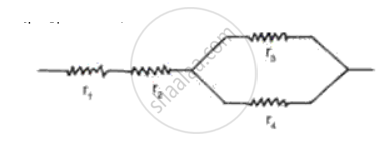Advertisements
Advertisements
प्रश्न
Find the equivalent resistance between A and B

उत्तर
6Ω and 3Ω are in parallel
`:.1/R_p= 1/R_1 + 1/R_2`
`:.R_(P_1) = 6.3/(6+3) = 18/9` = 2 Ω
4Ω and 2Ω are in parallel
`:. 1/R_P = 1/R_1 + 1/R_2`
`:. R_(P_2) = 4.12/(4+12) = 4.12/16 = 3 Ω`
`:. "Total" R_T = R_(P_1) + R_(P_2) = 2 + 3 = 5 Ω`
APPEARS IN
संबंधित प्रश्न
Write any two characteristics of a series combination of resistors.
If the length of a wire is doubled by taking more of wire, what happens to its resistance?
How does the resistance of a wire change when:
its length is tripled?
What is (a) highest, and (b)Ω lowest, resistance which can be obtained by combining four resistors having the following resistances?
4 Ω, 8 Ω, 12 Ω, 24 Ω
Calculate the equivalent resistance of the following combination of resistor r1, r2, r3, and r4

How does the resistivity of a semiconductor depend on temperature?
State expression for Resistance connected in parallel.
Three resistors of 6Ω, 3Ω and 2Ω are connected together so that their total resistance is greater than 6Ω but less than 8Ω Draw a diagram to show this arrangement and calculate its total resistance.
Illustrate-combination of cells e.g., three cells, in series, explaining the combination briefly. Obtain an expression for current ‘i’ in the combination.
What is the maximum resistance which can be made using five resistors each of `1/5` W?
